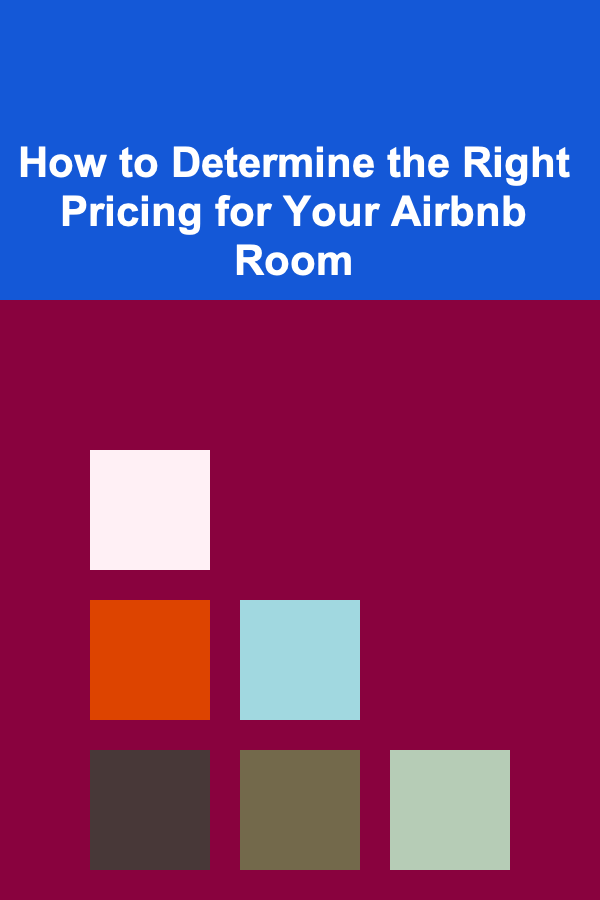
How to Determine the Right Pricing for Your Airbnb Room
ebook include PDF & Audio bundle (Micro Guide)
$12.99$10.99
Limited Time Offer! Order within the next:

Setting the right price for your Airbnb room is one of the most crucial decisions you'll make as a host. Pricing can directly influence your occupancy rate, the number of bookings you get, and ultimately, the success of your hosting business. Charge too much, and you risk scaring off potential guests; price too low, and you might not be maximizing your profits. So, how do you find the sweet spot that will make both you and your guests happy?
In this in-depth guide, we'll walk you through actionable strategies and data-driven methods for determining the right pricing for your Airbnb room. Let's dive into the factors that will influence your pricing decisions and explore how you can fine-tune your approach to achieve optimal results.
Understand the Market Demand
Market Research: Know Your Competitors
The first step in setting the right price is understanding the competitive landscape. Take time to research other Airbnb listings in your area that are similar to yours in terms of size, location, amenities, and style. Pay attention to the following factors:
- Location: Prices can vary drastically based on your city or neighborhood. A listing in a prime tourist area will command a premium price, while a room in a less traveled location may require a more competitive pricing strategy.
- Amenities: Does your room offer additional amenities such as air conditioning, a private bathroom, Wi-Fi, or free parking? Listings with more attractive features tend to justify higher prices.
- Size and Type of Property: A private room in a shared apartment will generally cost less than a standalone studio or one-bedroom apartment. Make sure you compare similar properties.
- Seasonality: Understand how your pricing needs to adjust based on peak travel seasons, holidays, or local events. You may need to increase your prices during high-demand periods or reduce them during off-peak times to remain competitive.
By researching listings on Airbnb and competitor platforms, you'll get a good sense of what other hosts are charging and how your room compares.
Use Airbnb's Price Tips Feature
Airbnb offers a built-in feature called Price Tips, which provides price recommendations based on your listing details and market trends. This is a valuable tool for getting an idea of the average price for a similar listing in your area. While it's not always perfect, it can give you a rough baseline from which to adjust your price.
Factor in Your Operating Costs
When determining your price, it's essential to consider all of your operating costs. You want to ensure you're not just covering your expenses but also making a profit.
Key Costs to Consider:
- Cleaning Fees: Airbnb allows you to charge a cleaning fee, which varies depending on the size and complexity of the cleaning. Make sure you account for this when setting your nightly price, as it's typically added on top of the room rate.
- Utilities and Supplies: If you provide utilities like electricity, water, and Wi-Fi, make sure to include these costs in your pricing strategy. Additionally, think about the cost of supplies such as toiletries, towels, bed linens, and other amenities you provide.
- Maintenance and Repairs: Factor in ongoing maintenance costs, including furniture upkeep, repairs, and replacements for items like appliances and linens.
- Airbnb's Service Fees: Airbnb charges hosts a service fee, which is usually around 3% of the booking subtotal. Make sure to include this fee when calculating your pricing to ensure you're covering your costs.
Utilize Dynamic Pricing Tools
Pricing manually based on your instincts can lead to missed opportunities or uncompetitive pricing. To ensure you're adjusting your prices in real-time and maximizing revenue, consider using dynamic pricing tools.
What is Dynamic Pricing?
Dynamic pricing adjusts your listing price automatically based on demand, competition, and market conditions. These tools analyze factors like local events, seasonality, and market trends to optimize your pricing, helping you increase your revenue without much manual effort.
Popular Dynamic Pricing Tools for Airbnb:
- Airbnb Smart Pricing: This built-in tool automatically adjusts your price based on demand and other factors, but it can sometimes be too broad for more precise control.
- Beyond Pricing: A popular dynamic pricing tool that provides detailed data and adjusts prices based on the supply and demand of the area, competitive prices, and seasonal trends.
- PriceLabs: Another popular dynamic pricing tool that integrates with Airbnb and other booking platforms. It gives you more granular control over price adjustments while also providing reports and analytics to guide your decisions.
By using a dynamic pricing tool, you can ensure that your listing remains competitive in the market while maximizing your profits.
Experiment with Pricing Models
Don't be afraid to test different pricing models and see what works best for your listing. Here are a few common pricing strategies you can experiment with:
1. Weekly and Monthly Discounts
Offering discounts for longer stays (like a weekly or monthly rate) can attract guests who are looking for extended stays. Many travelers prefer to book for a week or longer to secure a lower rate. By offering these discounts, you can increase your occupancy rate without significantly reducing your overall profit.
- Weekly Discounts: Typically, offering a 10-15% discount for guests staying 7 nights or more can make your listing more appealing to longer-term travelers.
- Monthly Discounts: Offering a significant discount (e.g., 20-30%) for guests booking for a month or more can be attractive for remote workers or long-term visitors.
2. Minimum Stay Requirements
Setting a minimum stay requirement can help you avoid low-value bookings that might not justify the time and effort you put into hosting. If your area is popular for weekend getaways, you may want to set a minimum stay of 2-3 nights during weekends. Conversely, for slower periods, you might consider lowering the minimum stay to attract more short-term bookings.
3. Last-Minute Discounts
Offering a last-minute discount (typically for bookings made within a few days of arrival) can help fill up any unbooked days. This can be particularly useful in the off-season or when you're looking to increase your occupancy rate.
Account for Special Occasions and Events
Local events such as concerts, festivals, sports games, or conferences can dramatically affect demand for Airbnb rooms. For example, if there's a large event happening near your listing, you can raise your price to take advantage of increased demand. Be aware of these events and adjust your prices accordingly.
You can use tools like Google Trends or check local event calendars to track major happenings in your area. Additionally, Airbnb's own event calendar can give you insights into major events that might affect local travel trends.
Monitor and Adjust Pricing Regularly
Once you've set your pricing strategy, don't just leave it as is. Pricing should be an ongoing process of evaluation and adjustment. Monitor the following:
- Occupancy Rates: If you're getting too many bookings too quickly, you may want to increase your price. On the flip side, if your room isn't getting any attention, consider lowering your price or adjusting your listing.
- Guest Feedback: Pay attention to guest feedback regarding the value of your listing. If guests feel they're getting a great deal, you might want to increase your prices gradually. If you're getting negative feedback on pricing, it may be time to adjust.
- Market Changes: Changes in the local market, such as new competitors entering the scene or changes in demand, should prompt you to reassess your prices.
Conclusion
Determining the right pricing for your Airbnb room is an art that combines market research, cost analysis, and real-time adjustments. By taking into account your competitors, understanding your costs, utilizing dynamic pricing tools, and staying on top of local events, you can fine-tune your pricing strategy for maximum profitability. Remember, pricing is not a one-time decision; it's an ongoing process that requires flexibility and responsiveness to changes in demand. By keeping a close eye on these factors and making data-driven decisions, you can ensure that your Airbnb listing remains competitive, attracts guests, and provides you with a profitable return on your investment.

How to Keep Your Home's Garage Organized and Efficient
Read More
How to License Your Deep Learning Models for Ongoing Revenue
Read More
How to Optimize Your Bedroom for Better Storage Solutions
Read More
How to Plan a Staycation with Family Activities for All Ages
Read More
How to Use a Whiteboard for Daily Task Management
Read More
How to Use a Zero-Based Budget for Home Expenses
Read MoreOther Products

How to Keep Your Home's Garage Organized and Efficient
Read More
How to License Your Deep Learning Models for Ongoing Revenue
Read More
How to Optimize Your Bedroom for Better Storage Solutions
Read More
How to Plan a Staycation with Family Activities for All Ages
Read More
How to Use a Whiteboard for Daily Task Management
Read More